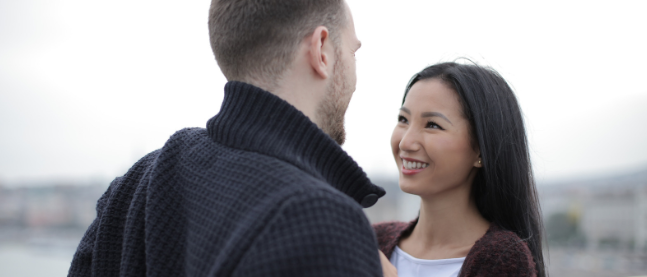Stop struggling with awkward eye contact by using the 'Triangle Method'
This will make your next conversation a lot more comfortable.
A woman staring a man in the eye.
Being good at making eye contact is a key factor in a successful social and professional life. It's a make-or-break skill because good eye contact can make you seem likable, while poor eye contact can make you appear shifty. "Eye contact produces a powerful, subconscious sense of connection that extends even to drawn or photographed eyes," according to Forbes.
Studies show that maintaining good eye contact conveys trust, empathy, and social connection. Difficulty maintaining eye contact can create discomfort, distrust, and disconnection. However, maintaining eye contact with others can be uncomfortable, especially for neurologically atypical people.
What is the Triangle Method for making eye contact?
That's where the "Triangle Method" comes in; it's a relaxed way to create the illusion of eye contact while gazing at a more comfortable spot on the other person's face. There are two versions of the Triangle Method: one for more formal, professional interactions and another for more relaxed, social conversations.

Here's how the Triangle Method works:
1. Make eye contact with the person you're speaking to by looking them in the eyes.
2. If this is a professional conversation, slightly lift your gaze to look at their brows. In a social setting, lower your gaze to look at their nose.
3. Return your gaze to their eyes.
4. Repeat this process throughout the conversation.
In other variations of the professional Triangle Method, you can look at the center of the forehead instead of the brows.
"When you're in a business situation, the area that you look at is the triangle that connects the forehead and the eyes," international etiquette expert Jacqueline Whitmore tells American Express. "That's what they call the business gaze."

Be sure to move your eyes slowly so they don't dart back and forth in a way that looks suspicious. The slight shift in your gaze as you move from the eyes to the brow line or nose tip probably won't be noticed by the person you're speaking to. It should look as if you're maintaining perfect eye contact, while giving yourself a break from holding an intense gaze.
How often should you make eye contact during a conversation?
People often wonder whether they're maintaining eye contact for too long or too short a time during a conversation. According to Magnet ABA Therapy, the best approach is the 50/70 rule. While speaking with someone, maintain eye contact 50% of the time. While listening to someone speak, hold eye contact for 70% of the time. Maintain eye contact for four to five seconds before slowly glancing away.

When in conversation, it's essential to focus on what the other person is saying and how you can contribute, rather than worrying about whether you're making appropriate eye contact. The Triangle Method is a great way to help people who are uncomfortable with eye contact focus on what's most important: the other person, not just their eyes.
